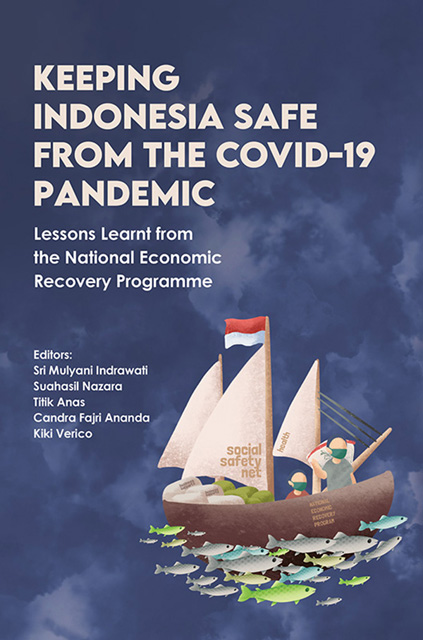 Keeping Indonesia Safe from the COVID-19 Pandemic
Keeping Indonesia Safe from the COVID-19 Pandemic Book contents
- Frontmatter
- Contents
- List of Figures
- List of Tables
- List of Boxes, Annexes and Appendixes
- Acknowledgements
- Glossary
- The Contributors
- Foreword: Keeping Indonesia Safe from the COVID-19 Pandemic Lessons Learnt from the National Economic Recovery Programme
- Part I Health Shock
- Part II Economic Shock: The Framework
- Part III Revenue Shock And Response
- Part IV Expenditure Side (Human Capital)
- Part V Expenditure Side (Msmes And Corporate Sector)
- Part VI Regional Dynamics
- Part VII New Ways Of Working
- Index
3 - Maintaining Macroeconomic Stability during the Pandemic
Published online by Cambridge University Press: 30 June 2023
- Frontmatter
- Contents
- List of Figures
- List of Tables
- List of Boxes, Annexes and Appendixes
- Acknowledgements
- Glossary
- The Contributors
- Foreword: Keeping Indonesia Safe from the COVID-19 Pandemic Lessons Learnt from the National Economic Recovery Programme
- Part I Health Shock
- Part II Economic Shock: The Framework
- Part III Revenue Shock And Response
- Part IV Expenditure Side (Human Capital)
- Part V Expenditure Side (Msmes And Corporate Sector)
- Part VI Regional Dynamics
- Part VII New Ways Of Working
- Index
Summary
INTRODUCTION
Indonesia was on a growth trajectory between 2010 and 2019 with annual growth rates averaging 5.4 per cent and was hopeful of achieving the high-income country status by 2045. In 2019 Indonesia managed to show a healthy macroeconomic status—growth reached 5.02 per cent, the inflation rate was manageable at 2.78 per cent, the Gini ratio was at 0.39, the rupiah appreciated by 5 per cent, and there was a 138-basis point decrease in Indonesia's ten-year government bond yield in the second half of the year.
In 2020, the World Bank classified Indonesia as an upper-middleincome country. Later, due to the COVID-19 pandemic, Indonesia was then reclassified as a lower-middle-income country. The unprecedented Wuhan outbreak surprisingly shook the global economy to its core in a manner we had never seen before, except perhaps during the Spanish flu pandemic in the early 1900s. At about the time the first COVID-19 cases began to appear, the world was under a cloud due to the US-China trade war which had caused a long period of economic uncertainty and increased geopolitical tension resulting in surging commodity prices. In Q4 2019, the global economy looked set to rebound. Capital flows started returning to emerging markets assets, including Indonesia. The rupiah appreciated by 5 per cent between 31 May 2019 and 31 January 2020, and the ten-year yield went down by 138 basis points during the same period.
COVID-19 first emerged in late December 2019 in Wuhan, China (WHO 2020) and was thought to be a pneumonia disease. By mid-February 2020, positive cases had reached close to 50,000 and spread across twenty-seven countries. By this time, the global market was still in its bullish tendency, with capital flows still flowing into the emerging markets. However, the disease spread fast, pushing the World Health Organization (WHO) to announce a pandemic status on 11 March 2020. At that time, the financial market was still unaware of what was coming but there were already more than 118,000 COVID-19 cases in over 110 countries.
The global financial market was priced in less than ten days after the WHO declared the pandemic. On 20 March 2020, there was a freeze in the global financial market. The Volatility Index (VIX) hit an all-time high of 53.54.
- Type
- Chapter
- Information
- Keeping Indonesia Safe from the COVID-19 PandemicLessons Learnt from the National Economic Recovery Programme, pp. 67 - 105Publisher: ISEAS–Yusof Ishak InstitutePrint publication year: 2022


